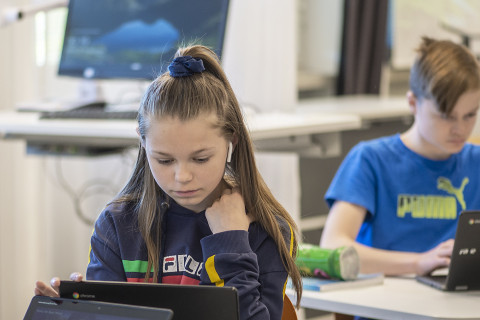Last year, the University of Eastern Finland launched a research project that promotes learning and teaching in a new way. The project’s objective is to explore how learning analytics can promote self-regulated learning and pedagogical planning that supports it. At the same time, the project examines how learning analytics can be used to support learning processes and to develop them in a high-quality manner.
- Text Nina Venhe | Photos Mostphotos
For the past 10 years, developers of online environments have had a great need to understand how people operate in different environments. The more the internet is used in daily activities, the more valuable this information is. Commercial operators, such as Google, do this work all the time.
“When we talk about online environments in the context of teaching and learning, things are still in their infancy. Although plenty of research is already being done on this subject, we do not yet have enough information on how digital learning platforms and the information collected from them could be used effectively in different learning environments. However, they could be a great help to both learners and teachers, and they could also be the ‘next step’ in research addressing learning and teaching processes,” says Professor Laura Hirsto, the director of the project.
Making data easily understandable
Because online environments have been used in teaching for years already, various data on learning and teaching processes are starting to cumulate. However, the storage and appropriate use of the data still require a lot of joint reflection.
“For a platform to provide optimal support for learning, teaching and pedagogical decision-making, it should also provide both teachers and learners with relevant data, and visualised data.”
For example, learners should see what stage their subject or course is at, when different assignments are due, and what should be done before that. They should also be able to qualitatively and quantitatively monitor their own learning and its level in real time so that everyone could improve their weaker areas, if they so wish. Ultimately, it should be possible to assess whether everything as a whole went as it should have, and to what extent the desired things or skills were learned.
“Teachers, on the other hand, should be able to obtain up-to-date information on how learners proceed in their studies and assignments, which assignments possibly are difficult, and what the achieved level of learning is. For example, if it seems that an assignment is challenging to several learners, it would be good to consider where more attention should be directed in teaching at that point. Also, it is possible to deal with difficulties right away.”
As the amount of data increases, it is also possible to understand learner behaviour. A teacher may notice that a certain method of teaching or an activity presents challenges to certain learners or, correspondingly, helps them to move forward.
“It would also be easier to tailor and recommend further training to more targeted groups according to their competence development needs,” Hirsto sums up.
Furthermore, all this should be easily visualised so that teachers and learners could easily understand the analytics. Visualisation would make it easier for both to draw conclusions on learning, and on the needs and focus of teaching.

Ethical issues in mind at all times
The University of Eastern Finland’s project has now reached a practical level. Research is carried out both at the university on various courses, as well as in comprehensive school.
“We are exploring the possibilities of learning analytics to support self-regulation among 5th and 6th grade pupils in the university's teacher training school.”
Ethical issues play a prominent role in learning analytics and in learning analytics research. Data are collected within the limits set by the data protection regulations, but questions such as who can use and utilise the data, who can store them and for how long, still need to be answered.
“The extent to which analytics guide learners’ perception of themselves as learners should also be taken into account, if analytics only focus on performance and scores, for example,” Hirsto points out.
In the past, learning analytics have been approached largely from a technical point of view.
“As educational scientists, we now want to emphasise that the learning process is not exclusively linear. Learning is a dynamic process with dimensions other than performance or the perspective of knowledge. Motivation, learners’ goals, and experiences of meaningfulness and inclusion also matter.”
Utilization of Learning Analytics in Supporting Self-Regulated Learning at Different Stages of the Educational Path (OAHOT) is a three-year project that secured 1.1 million euros of ERDF funding from Business Finland. As partners, the project involves the companies Valamis and SoleNovo, and the education technology platform ThingLink, all of them based in North Karelia. At the University of Eastern Finland, the project is implemented in collaboration between the Philosophical Faculty and the Faculty of Social Sciences and Business Studies, and with the teacher training school. The project also has international partners.
Project website
Project blog

